Abstract
It is of particular importance for structural geology, geophysical exploration and also obvious economical purposes to retrieve structures possibly hidden below salt domes. And these domes could trap hydrocarbon or gas. We thus propose a sensitivity analysis of seismic data in salt tectonic areas to identify different wavelengths associated with the geological structures under study involving salt domes. The wavelengths associated with the density or seismic velocities of the medium can give us information about the localization of shallow or deep geological structures surrounding salt domes in off-shore contexts. Seismic data can be more sensitive to density or to seismic velocities. Depending on the wavelengths associated with those two different properties, the dome shape and the different interfaces can be located and recovered at different depths. In a first approach, using velocity and density models from a salt tectonic region in the Gulf of Mexico we simulate a two-dimensional seismic data acquisition. Using these synthetic data, we aim at retrieving the salt dome shape as well as the surrounding and deepest geological layers. For this purpose, we propose to compute better imaging conditions by attenuating free surface multiples and introducing an adjoint theory-based reverse time migration (RTM) method, enhancing the limits of salt bodies and also the layers under salt structures. To obtain these imaging conditions, we compute the compressional and density sensitivity kernels \(K_\lambda\) and \(K_\rho\) using seismic sources activated separately. To attenuate the free surface multiples, the synthetic “observed” data computed with the free surface are introduced as adjoint sources and we replace the free surface condition by PML absorbing conditions in both the forward, backward and adjoint simulations needed to compute the kernels. We compare the quality of the kernels applying different strategies related to the normalization of kernels by the forward or adjoint energy, and different property parametrizations were tested to improve the imaging conditions. The specific wavelengths associated with the different (shallow to deep) interfaces are obtained using signal-to-noise ratios (SNRs) applied to both density and seismic velocity kernels. In some cases, density or seismic velocity kernels are more suited to retrieve the interfaces at different depths.





















Similar content being viewed by others
References
Baysal E, Kosloff DD, Sherwood JW (1983) Reverse time migration. Geophysics 48(11):1514–1524
Behura J, Forghani F (2012) A practical approach to prediction of internal multiples and ghosts. In: SEG technical program expanded abstracts 2012, society of exploration geophysicists, pp 1–5
Berkhout A, Verschuur D (2006) Imaging of multiple reflections. Geophysics 71(4):SI209–SI220
Chang WF, McMechan GA (1986) Reverse-time migration of offset vertical seismic profiling data using the excitation-time imaging condition. Geophysics 51(1):67–84
Chattopadhyay S, McMechan GA (2008) Imaging conditions for prestack reverse-time migration. Geophysics 73(3):S81–S89
Claerbout JF (1971) Toward a unified theory of reflector mapping. Geophysics 36(3):467–481
Claerbout JF, Green C, Green I (1985) Imaging the earths interior, vol 6. Blackwell scientific publications, Oxford
Dellmour R, Stueland E, Lindstrom S, Tari G, Purkis S (2016) The håpet dome in the norwegian barents sea, structural evolution and morphometry of salt basins. In: Proceedings of the 78th EAGE conference and exhibition 2016, European association of geoscientists and engineers, vol 2016, pp 1–5
Durrani T, Bisset D (1984) The radon transform and its properties. Geophysics 49(8):1180–1187
Feng Z, Schuster GT (2017) Elastic least-squares reverse time migration. Geophysics 82(2):S143–S157
Foster DJ, Mosher CC (1992) Suppression of multiple reflections using the radon transform. Geophysics 57(3):386–395
Gholami A (2017) Deconvolutive radon transform. Geophysics 82(2):V117–V125
Guo P, McMechan GA (2020) Up/down image separation in elastic reverse time migration. Pure Appl Geophys 177:4811–4828
Guo P, Guan H, McMechan GA (2020) Data-and model-domain up/down wave separation for reverse-time migration with free-surface multiples. Geophys J Int 223(1):77–93
Jakubowicz H (1998) Wave equation prediction and removal of interbed multiples. In: SEG technical program expanded abstracts 1998, society of exploration geophysicists, pp 1527–1530
Jia X, Guitton A, Singh S, Snieder R (2017) Subsalt Marchenko imaging: a gulf of Mexico example. In: SEG technical program expanded abstracts 2017, society of exploration geophysicists, pp 5588–5592
Jones IF (2012) Tutorial: incorporating near-surface velocity anomalies in pre-stack depth migration models. First Break 30(3)
Jones IF, Davison I (2014) Seismic imaging in and around salt bodies. Interpretation 2(4):SL1–SL20
Kaelin B, Guitton A (2006) Imaging condition for reverse time migration. In: SEG technical program expanded abstracts 2006, society of exploration geophysicists, pp 2594–2598
Kennett B (1979) The suppression of surface multiples on seismic records. Geophys Prospect 27(3):584–600
Komatitsch D, Martin R (2007) An unsplit convolutional perfectly matched layer improved at grazing incidence for the seismic wave equation. Geophysics 72(5):SM155–SM167
Lailly P, Santosa F (1984) Migration methods: partial but efficient solutions to the seismic inverse problem. Inverse prob Acoust Elastic Waves 51:1387–1403
Liu Q, Tromp J (2006) Finite-frequency kernels based on adjoint methods. Bull Seismol Soc Am 96(6):2383–2397
Liu Y, Chang X, Jin D, He R, Sun H, Zheng Y (2011) Reverse time migration of multiples for subsalt imaging. Geophysics 76(5):WB209–WB216
Liu Y, Hu H, Xie XB, Zheng Y, Li P (2015) Reverse time migration of internal multiples for subsalt imaging. Geophysics 80(5):S175–S185
Loewenthal D, Lu L, Roberson R, Sherwood J (1976) The wave equation applied to migration. Geophys Prospect 24(2):380–399
McCann D, Comas A, Martin G, McGrail A, Leveille J (2012) Seismic data processing empowers interpretation: a new methodology serves to mesh processing and interpretation. Hart’E&P
McMechan GA (1983) Migration by extrapolation of time-dependent boundary values. Geophys Prospect 31(3):413–420
Monteiller V, Chevrot S, Komatitsch D, Wang Y (2015) Three-dimensional full waveform inversion of short-period teleseismic wavefields based upon the sem-dsm hybrid method. Geophys J Int 202(2):811–827
Ortiz-Alemán J, Abreu-Torres J, Orozco-del Castillo M, Hernández-Gómez J (2019) Pattern recognition applied to attenuation of multiples in subsalt imaging. Pure Appl Geophys 176(6):2411–2424
Plessix RE (2006) A review of the adjoint-state method for computing the gradient of a functional with geophysical applications. Geophys J Int 167(2):495–503
Robertsson J, Blanch J, Gupta H (2011) Encyclopedia of solid earth geophysics
Sacchi MD, Ulrych TJ (1995) High-resolution velocity gathers and offset space reconstruction. Geophysics 60(4):1169–1177
Soleimani M, Aghajani H, Heydari-Nejad S (2018) Salt dome boundary detection in seismic image via resolution enhancement by the improved nfg method. Acta Geod Geoph 53(3):463–478
Tarantola A (1984) Inversion of seismic reflection data in the acoustic approximation. Geophysics 49(8):1259–1266
Tromp J, Tape C, Liu Q (2005) Seismic tomography, adjoint methods, time reversal and banana-doughnut kernels. Geophys J Int 160(1):195–216
Vdovina T, Bansal R, Baumstein A, Tang Y, Yang D (2015) Multistage full wavefield inversion process that generates a multiple free data set. US Patent 20160238722A1
Verschuur D, Berkhout A (1992) Surface-related multiple elimination: practical aspects. In: SEG technical program expanded abstracts 1992, society of exploration geophysicists, pp 1100–1103
Virieux J (1986) P-sv wave propagation in heterogeneous media: velocity-stress finite-difference method. Geophysics 51(4):889–901
Virieux J, Operto S (2009) An overview of full-waveform inversion in exploration geophysics. Geophysics 74(6):WCC1–WCC26
Wang Y, Chang X, Hu H (2013) Simultaneous reverse time migration of primaries and free-surface related multiples without multiple prediction. Geophysics 79(1):S1–S9
Wapenaar K, Broggini F, Snieder R (2012) Creating a virtual source inside a medium from reflection data: heuristic derivation and stationary-phase analysis. Geophys J Int 190(2):1020–1024
Wapenaar K, Thorbecke J, Van Der Neut J, Broggini F, Slob E, Snieder R (2014) Marchenko imaging. Geophysics 79(3):WA39–WA57
Weglein AB, Gasparotto FA, Carvalho PM, Stolt RH (1997) An inverse-scattering series method for attenuating multiples in seismic reflection data. Geophysics 62(6):1975–1989
Whitmore ND (1983) Iterative depth migration by backward time propagation. In: SEG technical program expanded abstracts 1983, society of exploration geophysicists, pp 382–385
Yang Z, Hembd J, Chen H, Yang J (2015) Reverse time migration of multiples: applications and challenges. Lead Edge 34(7):780–786
Zhang D, Schuster GT (2013) Least-squares reverse time migration of multiples. Geophysics 79(1):S11–S21
Zhang Y, Duan L, Xie Y (2015) A stable and practical implementation of least-squares reverse time migration. Geophysics 80(1):V23–V31
Zhu H, Tromp J (2013) Mapping tectonic deformation in the crust and upper mantle beneath Europe and the North Atlantic ocean. Science 341(6148):871–875
Acknowledgements
Authors acknowledge research projects SENER-CONACYT 128376, IMP H.61006. Javier Abreu Torres acknowledges scholarship grant No. 678864 from PNPC-CONACYT. We also thank the CALMIP supercomputing mesocenter of Toulouse, France, for their support through project P1135 on the Olympe supercomputer platform and the TGCC/GENCI supercomputing center through project gen6351 on the IRENE supercomputer.
Author information
Authors and Affiliations
Corresponding author
Additional information
Publisher's Note
Springer Nature remains neutral with regard to jurisdictional claims in published maps and institutional affiliations.
Rights and permissions
About this article
Cite this article
Abreu-Torres, J., Martin, R., Ortiz-Alemán, J.C. et al. Salt Tectonic Modeling Using Reverse Time Migration Imaging and Sensitivity Kernel Wavelength Analysis. Surv Geophys 43, 703–736 (2022). https://doi.org/10.1007/s10712-021-09689-7
Received:
Accepted:
Published:
Issue Date:
DOI: https://doi.org/10.1007/s10712-021-09689-7




